Teams Phone Connector SIP Trunk Configuration Step-By-Step Guide
Table of Contents
Prerequisites: Step 1 - Assign Microsoft licences Step 2 - Add the Enterprise Step 3 - Direct Routing Step 4 - Add Trunk Profile Step 5 - Manage Trunk Profiles and Trunk Users Next Steps to Consider:Prerequisites:
Reseller Admin Access to the Microsoft Teams Connector Portal.
This article is a step-by-step guide to initial provisioning of the Microsoft Teams Connector SIP Trunk. Start here, and follow links as needed for additional details and troubleshooting.
This process will require collaboration between the Service Provider/Reseller and the Microsoft Global Administrator for the Enterprise. Some tasks can be delegated from the global admin to the "Microsoft Teams Service Admin" and "Skype Admin,” but due to Microsoft's security policies, the setup cannot be completed without the Global Administrator's initial involvement.
Step 1 - Assign Microsoft licences
Before beginning wil the Microsoft Teams Phone Connector, each planned Microsoft Teams user must have the correct licenses assigned to them. Somtimes due to high Traffic Microsoft can take up to 24 Hours to activate licenses after they have been assigned, so doing this ahead of time will streamline the rest of the process. Ensure there is one additional set of licenses available and unassigned as a direct routing user. These additional licences can be recovered once the setup has been completed.
If there is a cancelled/suspended trial license and a valid license is added with the same name - the customer should make sure that the cancelled trial subscription is removed from their license listing. If not, Microsoft only returns the cancelled/suspended SKU and the software will erroneously claim that the proper licenses are not available.
Step 2 - Add the Enterprise
As a reseller you will use the Microsoft Teams Connector Portal to add the new Enterprise, ensuruing the email user for registration belongs to the Microsoft Global Administrator tor the new enterprise. This will automatically send and email with a link to start the set-up process.
Add a New Enterprise
- Log in to the Microsoft Teams Connector Provisioning Portal
- Navigate to Enterprises

- Click Add Enterprise

The "Add Enterprise" form will load.

- Complete the following fields.
- Enterprise Name: Name of the client. Enter the enterprise name that will show up in the portal. Note: The Enterprise name should have a minimum length of 5 and a maximum length of 50 characters.
- Enterprise Admin Email ID: Client's global admin email address. Enter the email address of the person who controls the Microsoft Enterprise Global Administrator** for your business customer.
- Services: Trunk
- User Limit: Leave blank
- Request Consent For Enterprise Management: Yes. The enterprise admin will receive an Action Item to Grant Consent if this option is checked.
- Country: Select United States
- Billing Reference: If you have an external billing system, enter the string that identifies this enterprise in your billing system. This string will appear in reports.
- Restrict Enterprise Admin Access: Check this if you (the reseller) will perform all enterprise management functions. The Enterprise Global Admin will still have to log into the Enterprise Portal to give consent to the Reseller. The "Request Consent for Enterprise Management" above must be checked.
- Click Submit
- The Global Administrator will immediately receive an invitation email to the Teams Connector Provisioning Portal. Before proceeding, they must set up Direct Routing.
You can monitor the status from the “Edit Enterprise” screen and on the dashboard under Enterprise Admin Action Items.

Note: The Microsoft Office Global Administrator is the highest level of administrative credentials in Office 365 administration. It is required to initially register with the TMC and to install the PBX Application. It can be used for the entire setup process or this can be delegated to another User with Teams Service Admin and Skype for Business Admin rights. Specifically, Users with those delegated rights can set up Direct Routing and Manage Users.
Resend Global Administrator Invitation Email
If the initial invitation email is not received, you can resend it to the Global Administrator.
- Log in to the Teams Connector Provisioning Portal
- Navigate to Reseller > Enterprises and locate the enterprise you'd like to resend the invitation.
- Click the three dots next to the enterprise and select Resend Invitation Email.
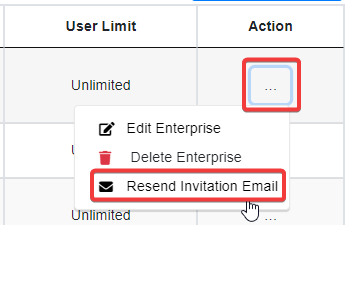
Step 3 - Direct Routing
- The Global Administrator of the Microsoft Tenant will receive an email from Microsoft Teams Phone with an invitation Code and a link to complete registration. This process was initiated when you created the Enterprise in the last step.
- Copy the Invitation Code and click on "Complete."
- Log in to the portal with Global Admin Credentials.
- Navigate to Enterprise > Direct Routing

- Ensure you have the correct Microsoft Office licensing. You must have at least one available AND unassigned User license with the Phone System or a comparable add-on that allows you to use Direct Routing. The Direct Routing page displays relevant licenses.
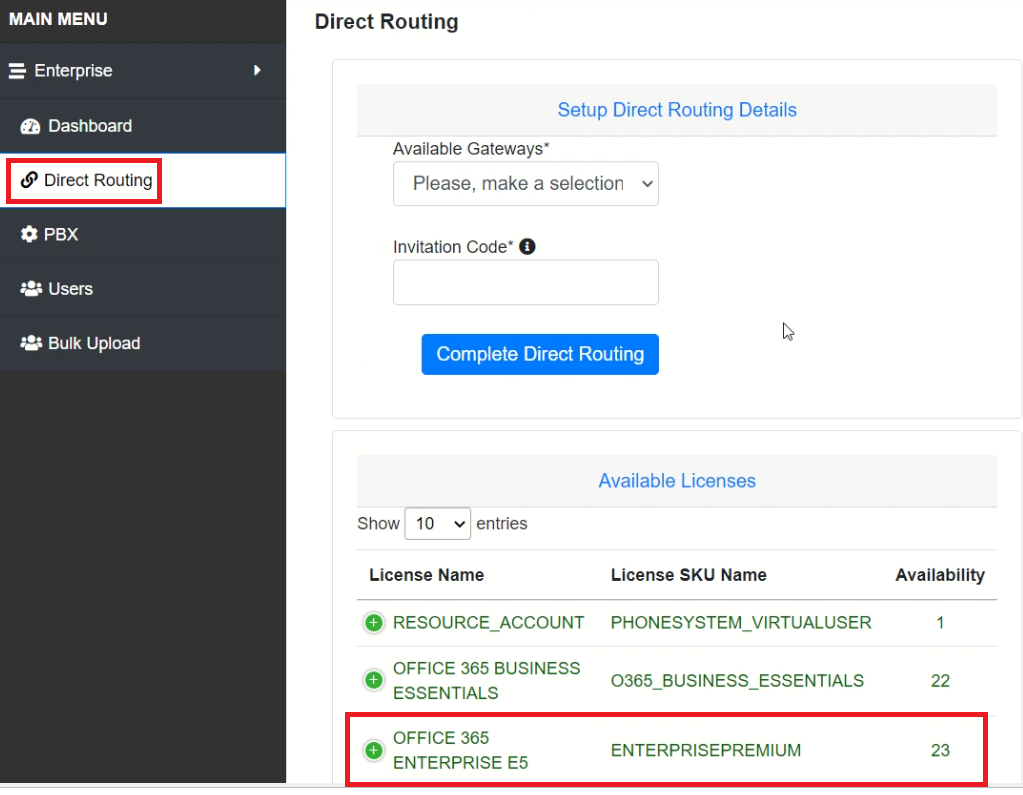
- Under Setup Direct Routing Details, select the desired Gateway.
- Paste the invitation code from the email.
- Then click "Complete Direct Routing.”
- The "Verify Tenant" will pop up, verifying the connection to the DNS Provider and validating licenses.
- Click "Complete Direct Routing" as soon as the verification is done.
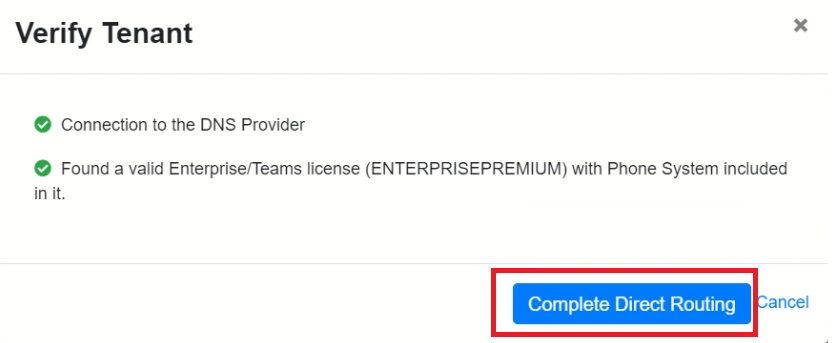

Direct Routing Completion
Direct Routing provisioning will take a few minutes; refresh the page after 2-3 minutes to check progress.
Direct Routing in Progress

When the Direct Routing setup is complete, you will receive an alert email at the Enterprise email address instructing you to continue with PBX Settings, User Management, and Teams Management (Application set up). On the Enterprise portal dashboard, your Direct Routing Connection Status will display complete.

If the direct routing process completes and the "Calling Enabled" indicator is still showing as red, like the screenshot below,
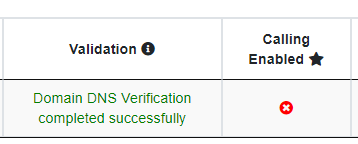
To initiate the direct routing process, click the "Finish" button on the right side of the Direct Routing page.

If that does not resolve the issue, please open a ticket with support.
Adding Additional Routes
If desired, it is possible to set up additional direct routes.
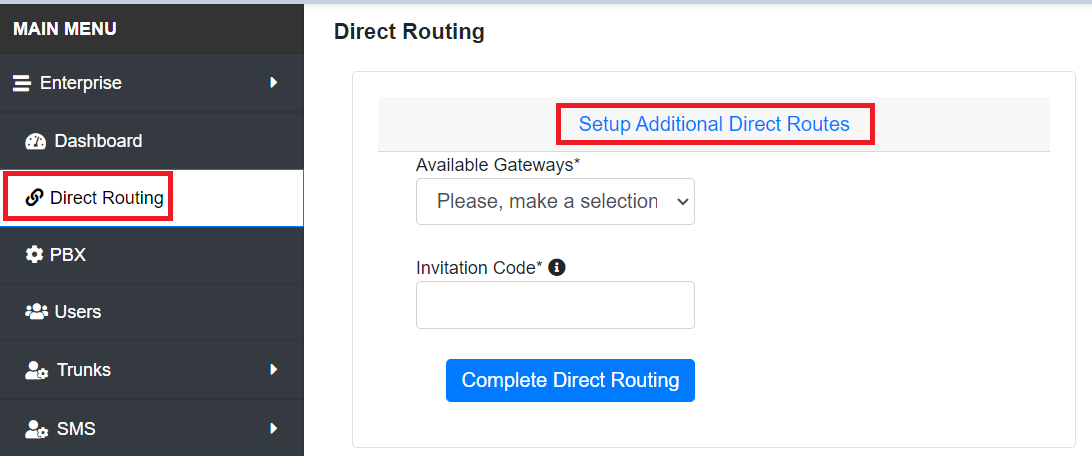
The form will be the same as the initial Direct Route. Use the same invitation code provided in the original email for all direct routes.
Each direct route creates a different Direct Routing User and consumes a Microsoft license, so remember to recover your licenses in the Microsoft Admin Center when you are done.
Step 4 - Add Trunk Profile
After the enterprise has configured Direct Routing, the reseller is responsible for setting up the trunk profile with information from the customer's telecom account.
Add Trunk Profile
This article provides guidance for filling out the form to add a trunk profile from the reseller provisioning portal.
From the Enterprise Dashboard, Navigate to “Trunk" then "Profiles” and click "Add Trunk Profile" in the upper right corner.

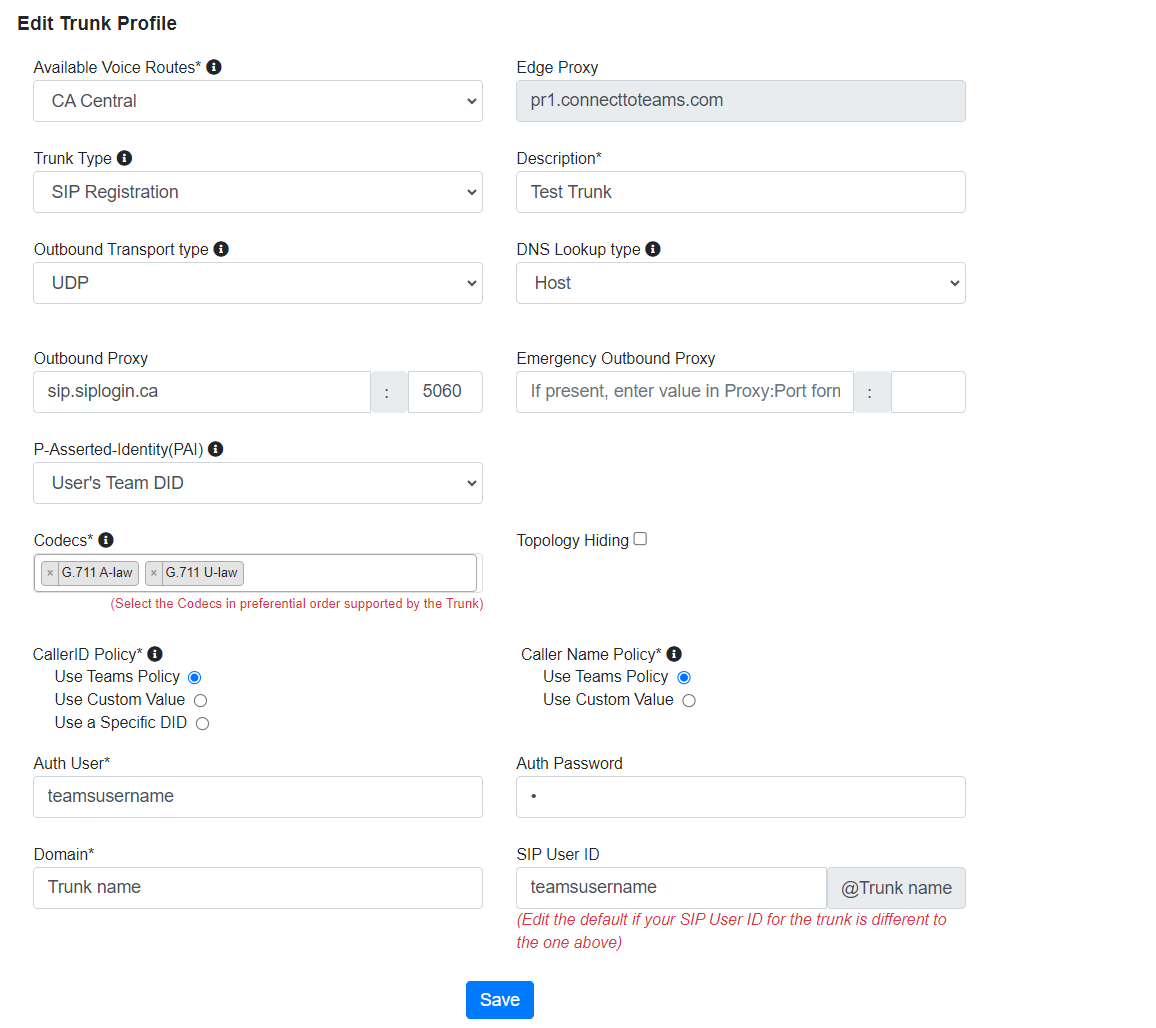
Available Voice Routes: Select one of your already-configured voice routes from the dropdown menu.
Trunk Type: Select the type of Authentication that your Trunk supports.
Description: What part of the business will this trunk service? Example: "Customer Service Trunk," or "Downtown Office."
Outbound Transport type: Select UDP, TCP, or combination.
DNS Lookup type: Host or SRV. NOTE: DNS/SRV is incompatible with proxy addresses, including ports. If your proxy address requires a port, you must use HOST.
Outbound Proxy and Port: sip.siplogin
Emergency Outbound Proxy and Port: Enter if configured on the trunk side. This is optional.
P-Asserted-Identity(PAI): Choose if it is from a number, the trunk default number, the trunk SIP user ID, or none.
Codecs: Select your codecs in order of preference; codecs will be attempted in the order you arrange.
Topology Hiding: check if you want to enable Topology Hiding
CallerID/Name Policy: Give you the option to customize the Caller ID and Caller Name transmitted to upstream systems for outbound calls.
Domain: SIP Domain. Refer to the client's account.
SIP User ID: This may be the same as the “Auth User” above, but some providers differentiate between SIP user names and SIP user IDs. This field will automatically populate as "(Auth User)@(Domain)" as you fill in the rest of the form. Review for accuracy before submitting.
Auth User: SIP User name
Auth Password: SIP Password
When complete, click "Add Trunk Profile" and review its status on the "SIP Trunk Profiles" page.

Step 5 - Manage Trunk Profiles and Trunk Users
This guide discusses the portal screens where you can view and manage listings of Trunk Profiles and Trunk Users.
Profiles
This screen shows all the configured trunks created for the enterprise along with features to manage the trunks and searching for specific trunks or disabled trunks.


Add Trunk Profile button: This button leads you to form where you can define a new trunk profile.
The SIP Trunk Profiles table lists all the trunk profiles created. Information shown in the table are:
- Domain: SIP Domain. Refer to the client’s account.
- Edge Proxy: This is the edge proxy in Microsoft Teams Connector network assigned to handle the trunk. This can't be edited so this is informational only.
- Description: Your descriptive identification of the trunk. You may use text like “Customer Service Trunk,” or “Downtown Office.”
- SBC Location: The gateway the route was built on.
- Outbound Proxy: The proxy address from the telecom provider being used.
- Registration: This indicates whether the trunk was properly configured and successfully registered to the trunk provider. This indicator sometimes has a delay in turning green; you may be able to place calls before the dashboard acknowledges the registration is successful.
- In Use: This indicates whether any users have been assigned to the trunk yet.
The Action options available for each trunk profile in are:
- Disable Trunk: Disabling the trunk will move the trunk to the Disabled Trunk list. Use the Advanced Trunk Search option to see such list.
- Edit: This is to modify the trunk profile configuration.
Disable Trunks button: Allows you to disable multiple trunks. When button is clicked, it shows you checkboxes so you could select multiple trunk profiles to disable.
Advanced Trunk Search button : This allows you to change records shown on the page. When in active trunk list view, you are given the option proceed to see list of Disabled Trunk Profiles. When in disabled trunk list view, you are given the option to go back to Active Trunk Profiles list.

Disabled SIP Trunk Profiles
This page lists all the disabled trunk profiles.

The Action options for each disabled trunk profile are:
- Delete Trunk: To delete the trunk permanently.
- Restore Trunk: To activate the trunk again. Once restored, the trunk profile will show in the active Trunk Profiles table mentioned above.
- Edit: This is to make modify the trunk profile definitions. For a refresher on the meaning of each field
Users
This screen shows the Teams users in the enterprise along with their trunk configuration. This also leads to trunk user management functionalities.

The Manage Users table lists the Teams users and their trunk configurations. Information shown in the table are:
- Teams User: The user’s Microsoft email address.
- Outbound Trunk: This shows the Trunk Profile if the user is configured for trunk service.
- Caller ID: This shows the assigned Caller ID if the user is configured for trunk service.
- License Details: This shows the status of the necessary Microsoft licenses for each user. All the license icons must be green to consider the user configuration complete.

The Action options for each user in the table are:

- Configure Trunk User: This leads to page for configuring a trunk user.
- Disable User: This removes the user registration and removes the trunk configuration. Disabled user can be restored and, if consent has not been granted to the provider, the Enterprise Admin has to perform a Teams Users sync operation to complete the user restoration.
- Disable Calling: Remove calling settings from Teams. Typically followed by Enable Calling on situations when troubleshooting call failure scenarios.
- Manage SMS: If Enterprise is enabled for SMS service, this leads page where this Teams user's SMS can be configured. (If Enterprise is also enabled for PBX Service, this Manage SMS is also available in the core Users page.)
For the changes to trunk user configuration to reflect in Microsoft Teams, the "Teams Users" must be sync'd.
If the Enterprise Admin did not grant the reseller the "Allow Management by Service" consent, the Enterprise Admin needs to "Sync Teams Users" action in the Enterprise Dashboard.

Action Buttons

Update Users button: Lets you update selected configured trunk Users. When button is clicked, it shows you checkboxes so you could select multiple users to update. See Updating Trunk Users section below for more on this.
The Disable Users button lets you disable selected configured trunk users. When the button is clicked, it shows checkboxes so you can select multiple users to delete. Disabling users are moved to a Disabled Users list.
Export Users button: Lets you export the configured trunk users.
When exporting trunk users, you will be given this message that indicates that a file generation process has started. To retrieve the file, click Downloads on the left menu pane.

Select User Groups button: Lets you define your enterprise organization groups that needs to be synchronized into ConnecttoTeams. This is similar to the User Groups Sync'ing ability in PBX.

This shows these search options:
- Disabled Users: This leads to page listing all disabled trunk users. In this page, you will have the option to delete the trunk configuration for users or restore (i.e., activate) users for trunk calling.
- Deleted Users: Lists all the deleted trunk users. In this page, you will have the option to restore deleted users.
- Unlicensed Users: lists all Teams users in the enterprise that doesn't have any of the necessary Microsoft license required for trunk calling.
Updating Trunk Users

When using the Update Users button to bulk update trunk users, the following fields are modifiable:
- Don't Update: Choose this if you do not wish to change the current DialPlan Policy settings of the selected users.
- Enable: Choose this if you want to assign the Reseller-defined Default Dial Plan policy to all selected users.
- Disable: Choose this if you do not want to assign all selected users the Reseller-defined Default Dial Plan policy.
Trunk Profile: If you want to update the Trunk Profile of all the selected users, select the target Trunk Profile.
Click on the “Next” button and confirm the prompt to complete the bulk trunk user update.